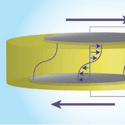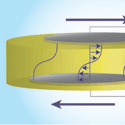Electrons or phonons–which are the bigger drag?
As two materials are dragged across one another, do conduction electrons at the surface make a significant contribution to friction?
An elegant approach to this deceptively simple question is to measure the friction between a metal and a monolayer of a simple gas, at temperatures above and below the metal’s superconducting transition. This turns the dissipative contribution from electrons “on” and “off,” respectively. Experiments of this kind between nitrogen gas and lead revealed that friction drops by a factor of below the lead superconducting transition, indicating electrons and phonons make roughly equal contributions to friction.
But, as Matteo Pierno, Giampaolo Mistura, and colleagues at Università di Padova and Università di Genova in Italy argue in Physical Review Letters, their friction experiments contradict these earlier experiments, leaving the various sources of friction an open question.
Pierno et al. coated the faces of a quartz disk with smooth layers of lead. Like the quartz crystal in a watch, the quartz disk is piezoelectric and oscillates in a shearing mode when excited by an ac voltage at its resonant frequency. When neon gas condenses on the lead surface, friction between the lead and neon layer dampen the oscillation.
However, Pierno et al. don’t measure a further change in the oscillation amplitude when they toggle the temperature back and forth across the superconducting transition. Within the sensitivity of their setup, they conclude that surface conduction electrons don’t contribute significantly to friction–a “null result” that suggests the interpretation of these measurements may be more complicated than previously thought. – Jessica Thomas





